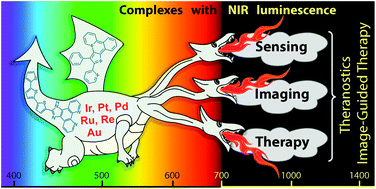Phosphorescent NIR emitters for biomedicine: applications, advances and challenges
Abstract
Application of NIR (near-infrared) emitting transition metal complexes in biomedicine is a rapidly developing area of research. Emission of this class of compounds in the “optical transparency windows” of biological tissues and the intrinsic sensitivity of their phosphorescence to oxygen resulted in the preparation of several commercial oxygen sensors capable of deep (up to whole-body) and quantitative mapping of oxygen gradients suitable for in vivo experimental studies. In addition to this achievement, the last decade has also witnessed the increased growth of successful alternative applications of NIR phosphors that include (i) site-specific in vitro and in vivo visualization of sophisticated biological models ranging from 3D cell cultures to intact animals; (ii) sensing of various biologically relevant analytes, such as pH, reactive oxygen and nitrogen species, RedOx agents, etc.; (iii) and several therapeutic applications such as photodynamic (PDT), photothermal (PTT), and photoactivated cancer (PACT) therapies as well as their combinations with other therapeutic and imaging modalities to yield new variants of combined therapies and theranostics. Nevertheless, emerging applications of these compounds in experimental biomedicine and their implementation as therapeutic agents practically applicable in PDT, PTT, and PACT face challenges related to a critically important improvement of their photophysical and physico-chemical characteristics. This review outlines the current state of the art and achievements of the last decade and stresses the most promising trends, major development prospects, and challenges in the design of NIR phosphors suitable for biomedical applications.

- This article is part of the themed collection: 2021 Frontier and Perspective articles


 Please wait while we load your content...
Please wait while we load your content...